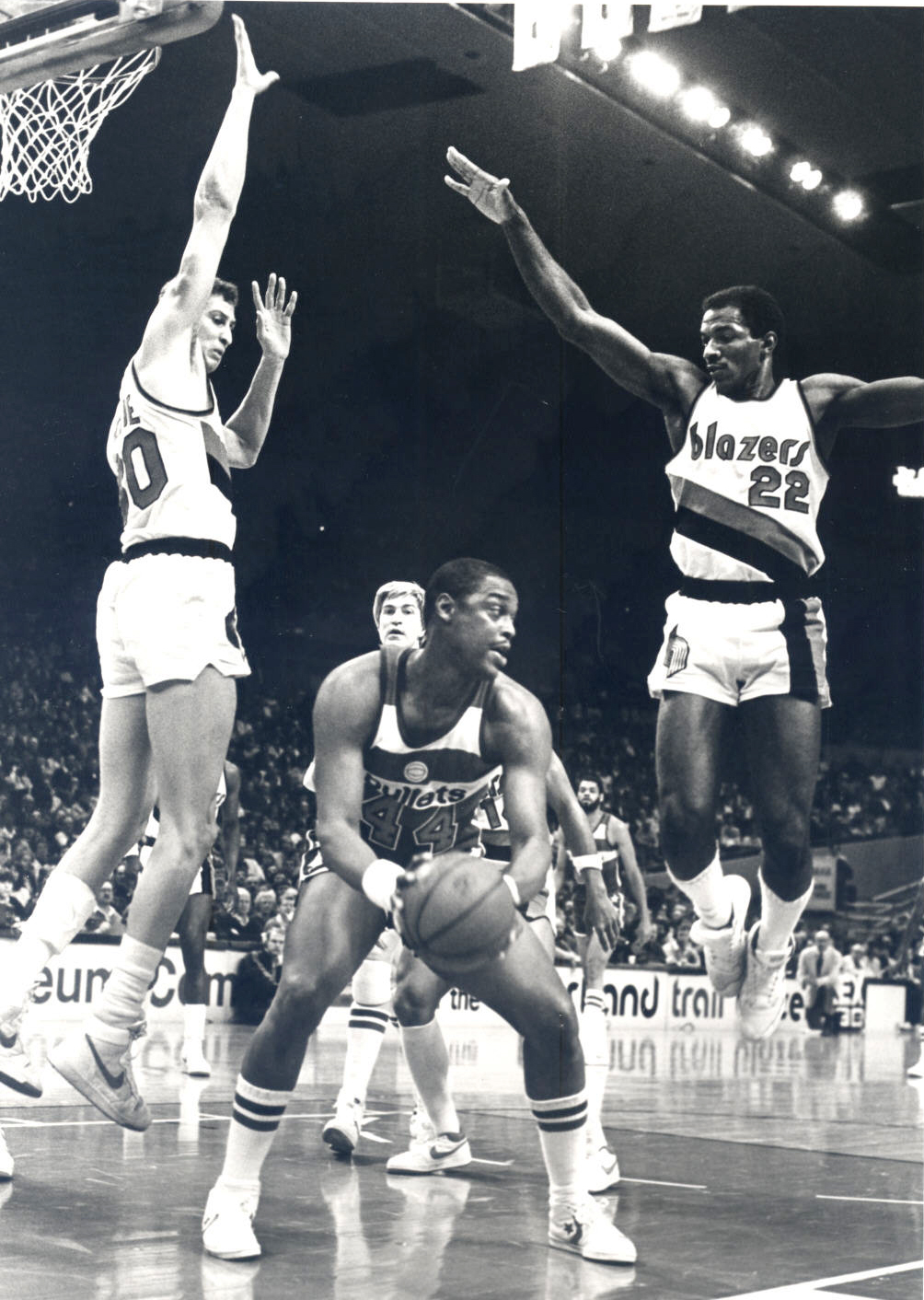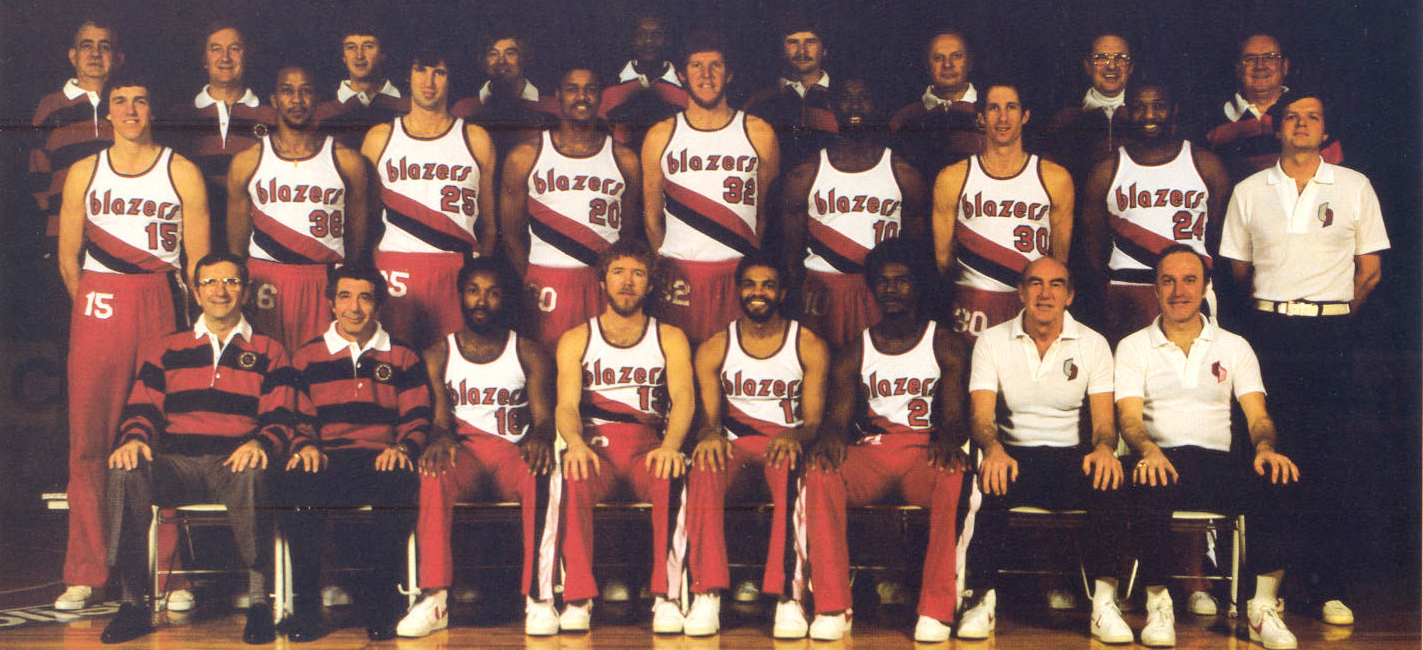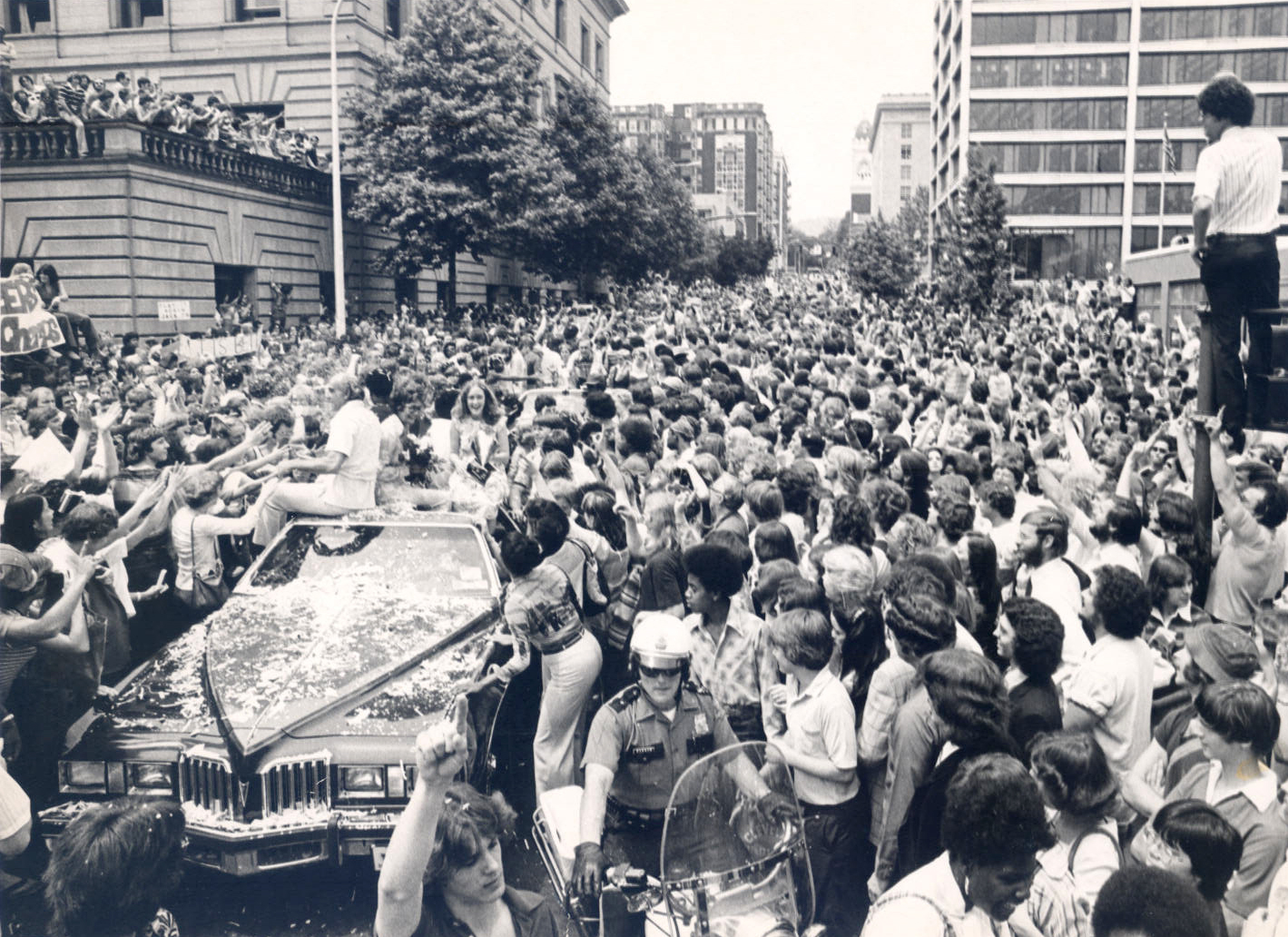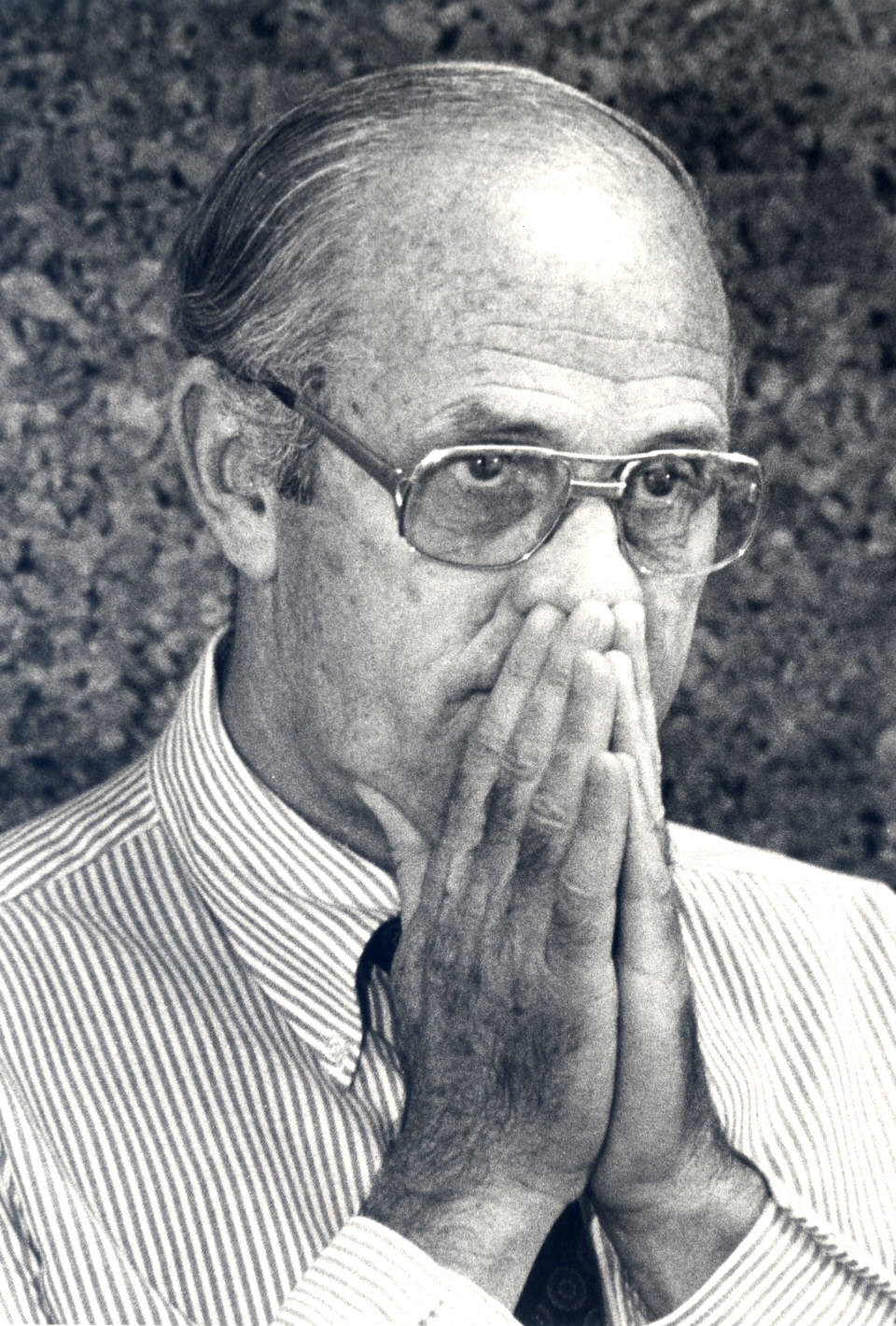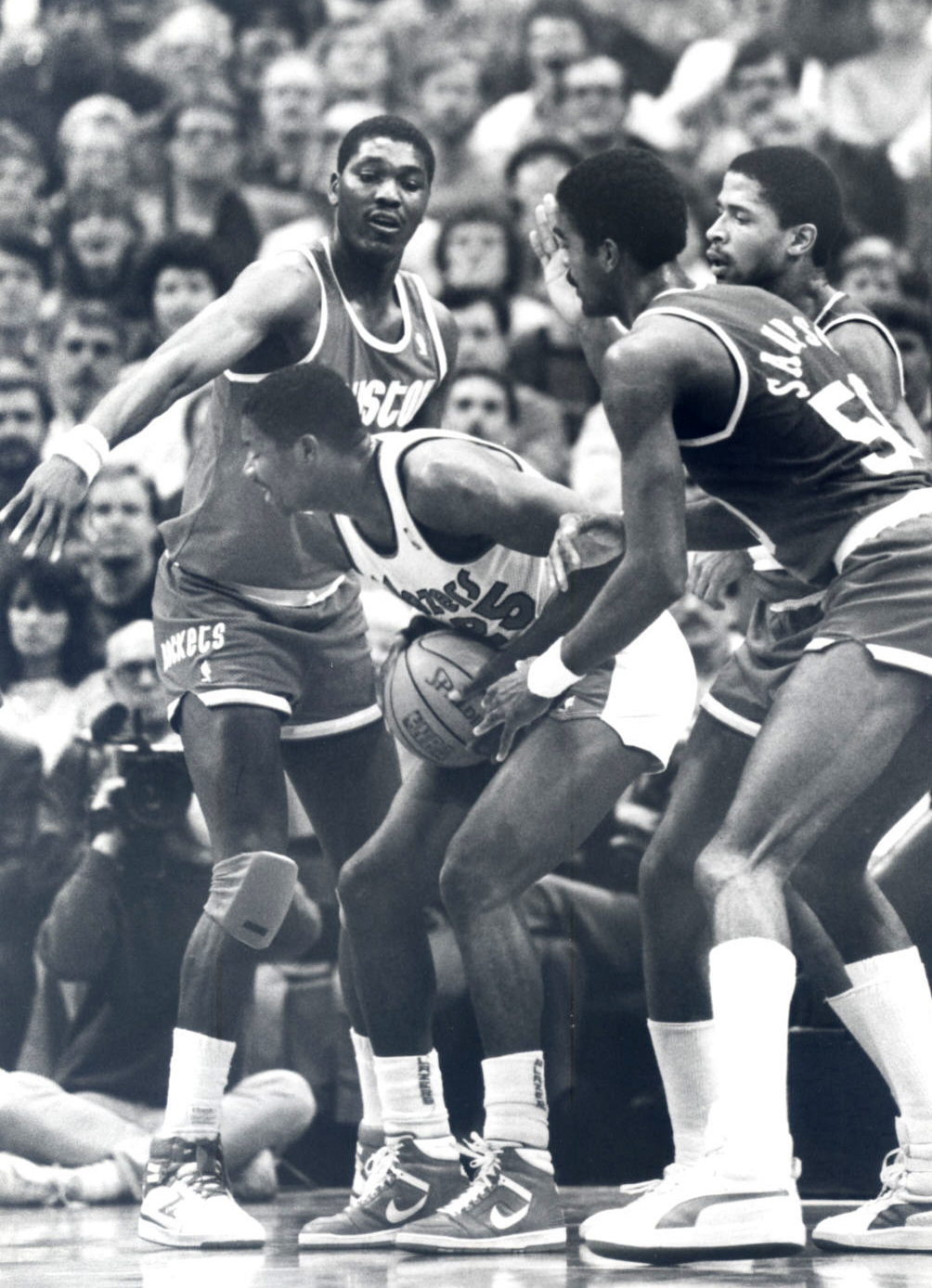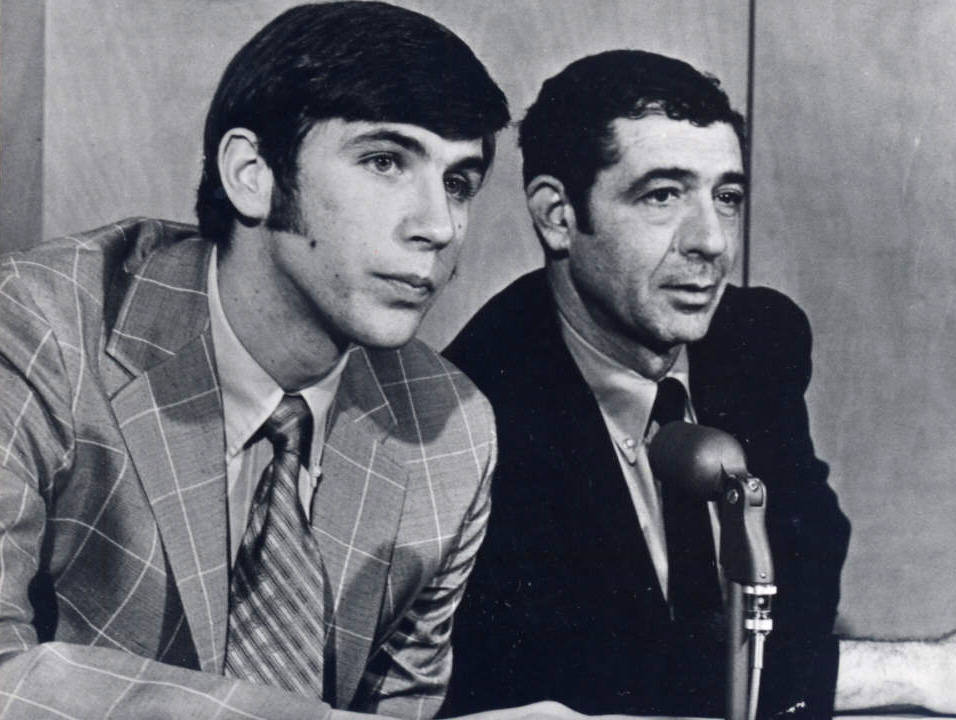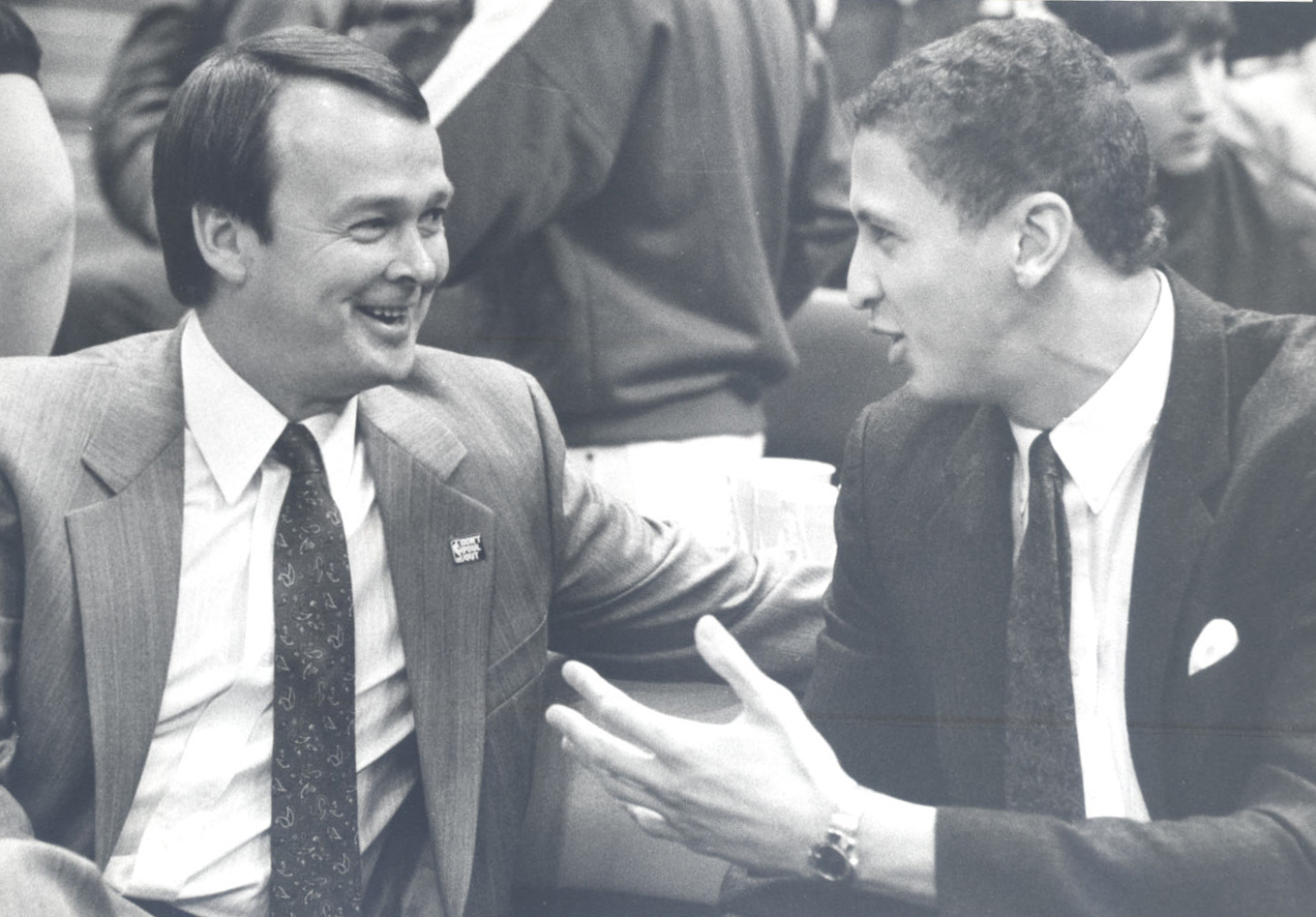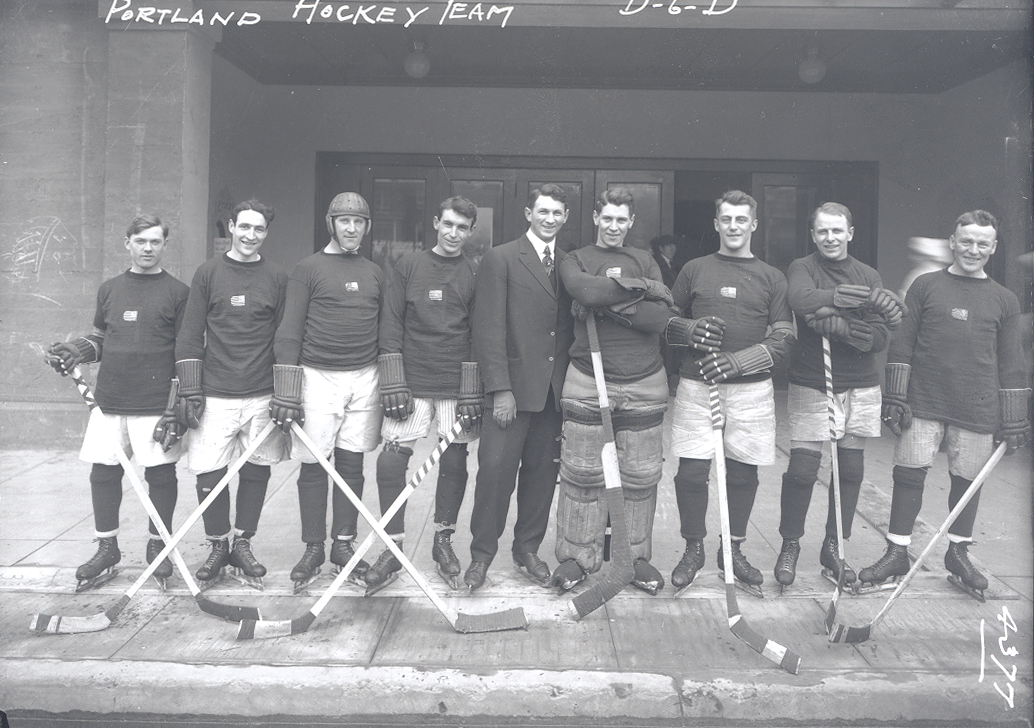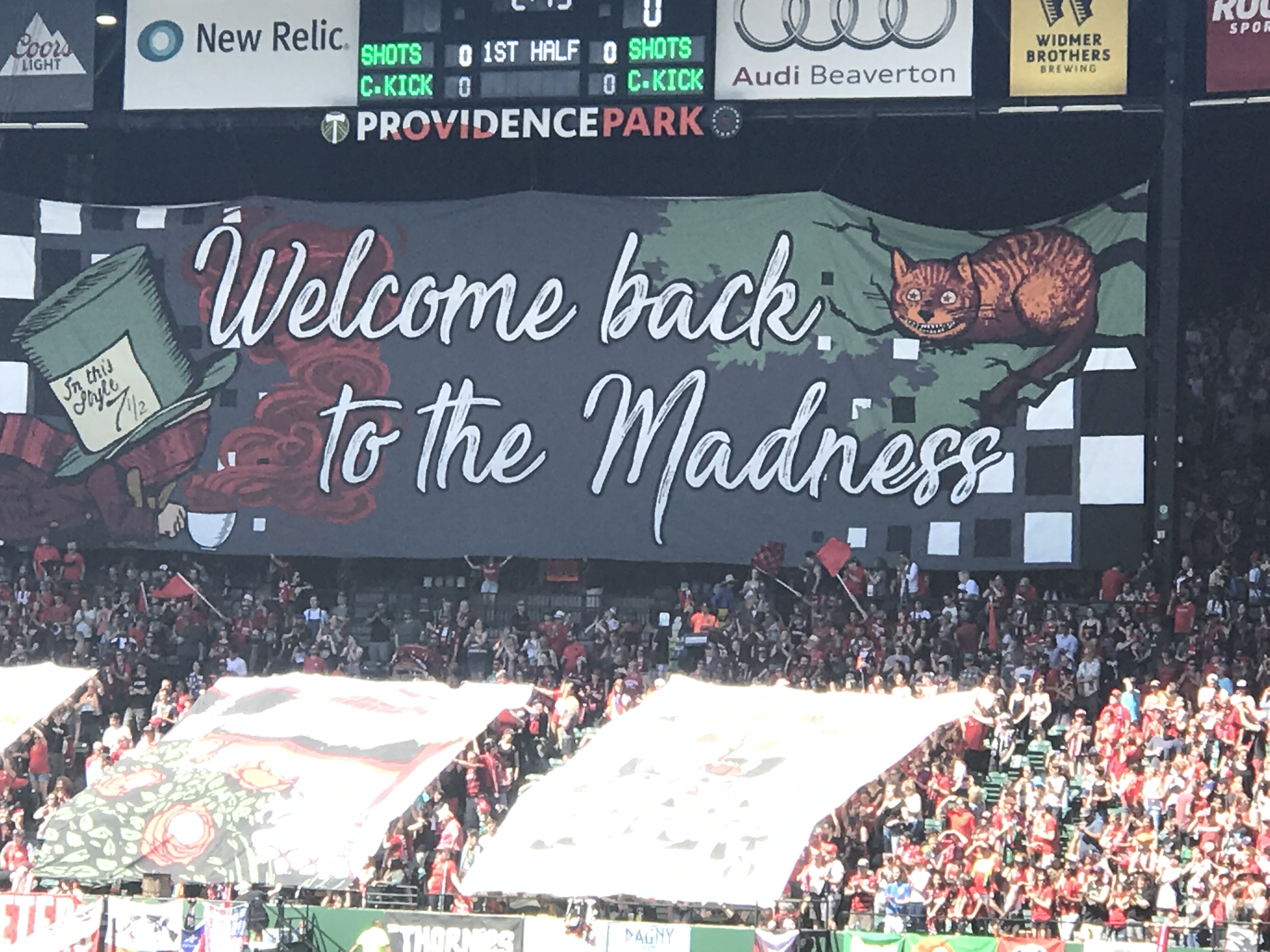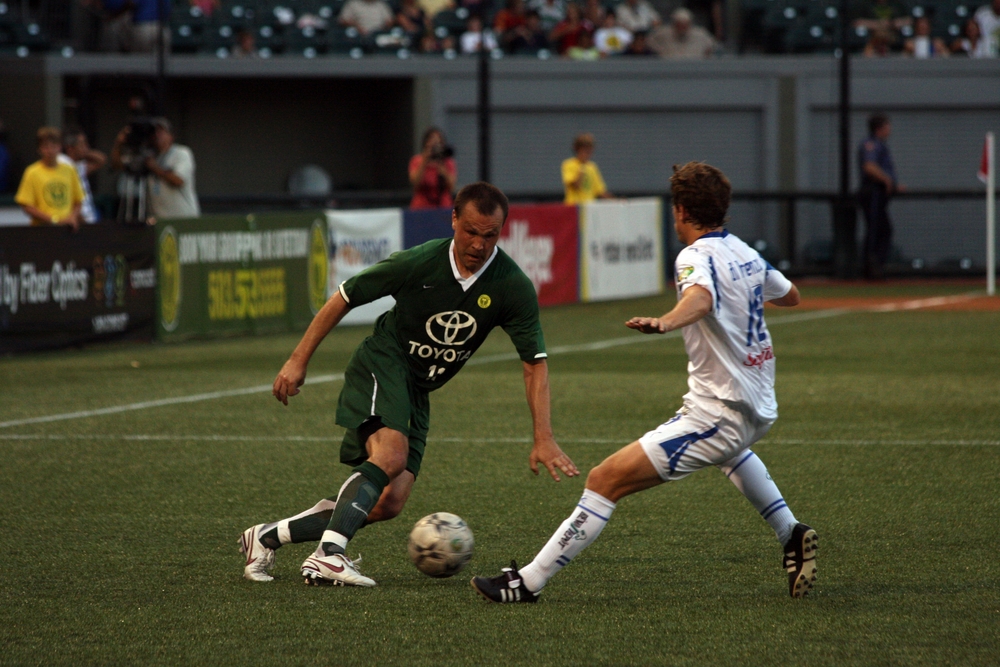The Early Years
It was February 1970 when at the last minute sports promoter Harry Glickman pulled together the funding and Portland was awarded a National Basketball Association franchise. The investors, who collectively contributed the necessary $3.8 million, were Herman Sarkowsky, Larry Weinberg, and Bob Schmertz. Portland joined Buffalo and Cleveland as new teams in the NBA that year.
Sarkowsky named Glickman the team’s executive vice president and general manager, and he quickly assembled a front-office staff that included Stu Inman, director of player personnel, and publicist John White. Rolland Todd, from University of Nevada, was hired as coach. White conducted a contest to find a name for the new team. Trail Blazers received the most votes.
In forming the first Trail Blazers team, Inman made some quality selections from the NBA’s expansion pool, including Rick Adelman and Pat Riley, who would go on to have distinguished coaching careers in the NBA, and veteran players LeRoy Ellis, Ed Manning, Jim Barnett, Stan McKenzie, Dale Schlueter, and Gary Gregor. From the NBA College Draft, he selected Geoff Petrie, a highly regarded shooting guard from Princeton. The Blazers finished its first season with a respectable 29–53 record, and Petrie shared Rookie of the Year honors with Boston’s Dave Cowens.
Portland drafted Sidney Wicks from UCLA with the second pick in the 1971 NBA draft, anticipating a high-scoring tandem with him and Petrie. But Wicks became a disruptive force, and in February Inman stepped in as coach on a temporary basis. The team struggled to an 18–64 finish.
Jack McCloskey, a successful coach at Wake Forest, was hired as coach in April 1972, allowing Inman to return to his personnel duties. The Blazers wasted its first draft pick on seven-foot-tall LaRue Martin when future Hall-of-Famer Bob McAdoo was available, and the team’s struggles continued. The Blazers ended the 1972–1973 season with a record of 21–61. When the 1973–1974 season ended with only marginal improvement (27–55), McCloskey was released and the Blazers hired Lenny Wilkens. That spring, the team drafted Bill Walton to join Petrie and Wicks. The team entered the 1974–1975 season with high hopes.
The Blazers improved significantly under Wilkens, winning 38 games in 1974–1975. They were in contention for a playoff spot even though Walton played in only 35 games. The following year, he played in 51 games, but the team won only 37. At the ownership level, Larry Weinberg bought out Sarkowsky to gain controlling interest of the team; and that spring, the team decided to let Wilkens go and hire Jack Ramsey, who had just completed his fourth season at Buffalo. Weinberg and Ramsey negotiated a contract for less money than Ramsey had made at Buffalo, but one that included healthy bonuses contingent on team success. Ramsey was optimistic that the team would succeed.
The Championship Team
Bill Walton was the main reason for Ramsey’s optimism. In the previous season (1976), he had played in enough games and accumulated good enough statistics (16 points and 13 rebounds per game) to indicate that he was both skilled and durable enough to have a major impact in the NBA. And Ramsey loved Walton’s team-first attitude and his ability to thread passes through defenders.
The Blazers also had selected solid personnel through the draft over the years. Larry Steele (1971), Dave Twardzik (1971), Lloyd Neal (1972), and Lionel Hollins and Bob Gross (1975) all played at the up-tempo level that Ramsey had envisioned. Before the 1976–1977 season began, Portland also acquired Maurice Lucas, Moses Malone, Johnny Davis, Herm Gilliam, Corky Calhoun, Wally Walker, and free agent Robin Jones. Within a short time, Weinburg traded Malone to Buffalo for its first pick in the draft, and the team went into the season without him.
Portland went on to win the NBA title in 1977. Walton, Lucas, and Neal were impressive in their physical play around the basket; and Gross, Steele, and Calhoun had the speed and agility to be excellent wing players. Hollins, Twardzik, Gilliam, and Davis were lightning-quick on the fast break, knocked down perimeter shots, and were bulldog tough on defense.
There was also a pervasive, unselfish attitude about the team that was visible to basketball experts and fans alike. On offense, anybody who was open got the ball. There were no forced shots, just smooth-flowing play that resulted in high percentage attempts on almost every possession. There was also a constant defensive awareness by every player, an unyielding determination to shut down opponents on critical plays. The team’s mental toughness never waned. It was a dream team, and the Blazers were “Red Hot and Rollin’.”
The long, 82-game NBA season did bring some speed bumps for the team. Walton missed 17 games due to injury, and the Blazers had not yet learned to win on the road. It was a young team—most of the players were in their early twenties—and seven players and two coaches were new to each other. The team also needed to acquire poise and confidence, especially on the road. By the end of the regular season, those things had been accomplished, and the Blazers were in the playoffs for the first time in franchise history.
Portland beat Chicago, 3–2, in the opening round of the playoffs as Walton contained Bulls center Artis Gilmore in Game 3. Then the Blazers overcame the loss of the injured Twardzik to defeat Denver, inspired by a brilliant performance by Johnny Davis in the decisive Game 6. In the Conference Finals against the Lakers, Herm Gilliam came to the team’s rescue in Game 2, Walton out-played Kareem Abdul-Jabbar throughout the series, and the Blazers swept Los Angeles 4-0.
In the NBA Finals against the Philadelphia 76ers, Maurice Lucas provided the psychological boost the Blazers needed to win at home after losing the first two games in Philadelphia. Gross and Hollins were outstanding throughout the series, Davis was rock-steady, and Walton came up with a classic performance in Game 6. Every player off the bench gave the team something positive, and the Blazers took the 1977 NBA Championship on June 5.
The City of Portland exulted in its happiness on a sunny Sunday afternoon after the last game. Fans drove along downtown streets, honking their horns, and neighborhood sidewalks remained crowded that evening as people from all over the city shouted “Go Blazers” and hugged one another. The next day, more than a quarter-million Blazer fans filled Broadway, and the caravan of open cars carrying the coaches and players had to inch its way through the crowd. Younger spectators climbed street lamps, office windows were filled with well-wishers throwing streamers and confetti, and the throng pressed in, hoping to touch hands with the players.
The Blazers were a better team in the 1977–1978 season. The players became more familiar with the system of play, and a quiet “nobody can beat us” confidence developed as Portland jumped out to a 50–10 start. But Walton developed foot pains, diagnosed as a neuroma between two of his toes. At the All-Star Game break, team doctor Robert Cook recommended surgery, a procedure that he anticipated would relieve the problem and keep Walton out of action for only about two weeks. Walton had the surgery, his discomfort continued, and he was sidelined for the rest of the regular season. In the first game of the playoffs against Seattle, he suffered a stress fracture in his foot and was finished for the season. Seattle won the series, 4–2.
With Walton’s injury, the Portland team structure, predicted by many to be a young dynasty, began to crumble. Walton sued the Blazers’ medical staff for incompetence and never played for the team again. Gross, Neal, and Twardzik suffered injuries that minimized their effectiveness. Lucas, Gross, and Hollins were unable to reach contractual agreements; and Davis, Calhoun, Gilliam, Walker, and Jones were eventually traded. The championship Blazers were no more.
Over the next eight years, with Ramsey as coach, Inman attempted to re-tool a championship team with a number of good players acquired through the NBA Draft and trades. The Blazers were always competitive, but they were not of championship caliber. Clyde Drexler, Mychal Thompson, Jim Paxson, Calvin Natt, Sam Bowie, Jim Brewer, Kermit Washington, Tom Owens, Kenny Carr, Jerome Kersey, Darnell Valentine, Fat Lever, Kiki Vandewegh, Kelvin Ransey, Wayne Cooper, Billy Ray Bates, and Terry Porter all performed well, but the Blazers lacked a Walton-type who could take the team to the top. All of those players were eventually traded or joined other teams through free agency.
Changes also occurred in the Portland front office. Weinberg brought Jon Spoelstra on board to run the business end of the franchise in Portland and added Harley Frankel to his Los Angeles staff. Spoelstra expanded the Blazers’ broadcast network, and he and Frankel became more involved in the basketball aspect of the franchise. In the process, Inman was nudged out and took on a similar position with the Milwaukee Bucks. Bucky Buckwalter assumed Inman’s personnel duties.
In the summer of 1986, Mike Schuler was named coach, and Ramsey took the head coaching job with the Indiana Pacers. That fall, Spoelstra was named general manager, and a year later Glickman was elevated to team president. Weinberg sold the team to billionaire computer magnate Paul Allen in 1988.
A New Era
In the spring of 1986, Buckwalter had made deals that affected the Blazers in the present and the future. He had traded Darnell Valentine to San Diego for Boston’s first pick in the 1986 NBA draft, and he had used that pick to acquire the rights to Arvydas Sabonis from Lithuania, one of the great international centers. He then made a trade that brought Steve Johnson to the team, and picked up Drazen Petrovic in the draft. In December, Buckwalter acquired Kevin Duckworth from San Antonio. The additions changed the Blazers’ front line from soft to formidable.
Portland improved to a 49–33 record in 1986–1987—and Schuler earned Coach of the Year honors—and had a 53–29 record in 1988–1989, but the Blazers were ousted from the playoffs in the first round both seasons. The team struggled the next year, and Schuler was replaced by assistant Rick Adelman in February l989.
Portland squeezed into the playoffs that year, but the team was swept in the first round by the Lakers. The Blazers drafted versatile forward Cliff Robinson that spring and acquired Buck Williams for Sam Bowie in a trade with New Jersey. The following season, 1989–1990, Geoff Petrie became general manager, and the Blazers finished 59–23. Adelman blended Drexler, Porter, Duckworth, and Kersey with Williams and used Robinson as a sixth man to form the best Blazers team since 1978. Portland went all the way to the 1991 NBA Finals, where it lost to Detroit, 4–1.
The Blazers had a better record the following season, 63–19, but lost to the Lakers in the Conference Finals. The team reached the NBA Finals again in 1992, when they lost to Michael Jordan and the Chicago Bulls, 4–2. The team had scrambled to the pinnacle of success but was unable to get over the top.
In the next two seasons, the Blazers were eliminated from the playoffs in the first round. In the spring of 1994, Adelman—who has the best winning percentage (.654) among Portland coaches in its history—was replaced by P.J. Carlesimo, and Bob Whittsit took over for Petrie.
Turmoil
From 1994 to 2003, with Whittsit as general manager, the Blazers frequently traded draft choices for veteran personnel. In the process, Portland acquired a number of players with troubled pasts. From 1995 to 2000, no player drafted played a significant role with the team; and in 1998 and 1999, Portland had no draft picks at all. It was not until 2001 that Portland selected a player— Zach Randolph—who had a positive impact on the team. Over several seasons, Whittsit acquired Isaiah Rider, Rasheed Wallace, Damon Stoudamire, Bonzi Wells, Ruben Patterson, and Shawn Kemp, each of whom had problems on or off the court. The Portland roster had become a revolving door.
The Blazers moved into the new Rose Garden arena in November 1995 before 21,398 spectators, a record crowd and its 814th consecutive. That streak ended a week later, but that mark of consecutive sellouts remains one of the longest of any franchise in professional sports. Portland posted respectable records, making the playoffs in four consecutive seasons (1995–1998), but was eliminated quietly in the first round each year. Then, amid revelations of frequent player-coach controversies, Carlesimo was replaced by Mike Dunleavy in the spring of 1997.
From 1997 to 2001, Dunleavy posted a .641 winning percentage and got his team to the Western Conference Finals twice. Sabonis had made his NBA debut the previous season; and in February 1998, Kenny Anderson, Gary Trent, and Alvin Williams were traded to Toronto for Damon Stoudamire, Walt Williams, and Carlos Rogers. The new combination played a bit better than .500 basketball for the remainder of the regular season, to finish at 46–36, and then was eliminated from the playoffs by the Lakers, 3–1. In the 1998–1999 season, the team advanced to the Western Conference Finals before being swept, 4–0, by San Antonio.
Dunleavy’s best season was in 1999–2000, when the Blazers roster had yet another group of new faces. He used a combination of Stoudamire, Steve Smith, Scottie Pippen, Wallace, and Sabonis with Wells, Greg Anthony, and Detleff Schrempf off the bench to jump out to a 40–11 start and finish the season 59–23. In the playoffs, Portland got past Phoenix (3–0) and Utah (4–2) to reach the Conference Finals for the second straight season. In Game 7 of that series with the Lakers, Portland appeared to have the game won by building a double-digit lead deep into the fourth period, but the Lakers rallied to win in the closing seconds. It was a bitter loss.
There were more trades before the 2000–2001 season. Shawn Kemp was acquired from Cleveland, and Dale Davis came to the Blazers from Indiana. Dunleavy patched together an effective lineup that finished the season 50–32, but Portland was ousted in the first round of the playoffs by the Lakers, 3–0. Dunleavy was replaced by Maurice Cheeks in June 2001.
Cheeks’s tenure started well enough—49–33 and 50–32—but the team’s failure to advance beyond the first round of the playoffs coupled with a 41–41 record in 2003–2004 and a disastrous beginning (5–22) in 2005 led to his replacement in February of that year. Pritchard filled the coaching role until Nate McMillan, coach of the Seattle Sonics, was hired that summer.
In the midst of those difficulties, Whittsit left the Blazers in the summer of 2003 to devote full attention to the Seattle Seahawks, Paul Allen’s NFL team. Soon after, Steve Patterson was named president of the Portland franchise, and John Nash joined the organization as general manager.
In 2004, Portland missed the playoffs for the first time in twenty-two years. Attendance in the Rose Garden dwindled, and the Blazers experienced unprecedented financial woes. The Oregon Arena Corporation, owners of the Rose Garden, declared bankruptcy and was taken over by a group of investment firms. Losing team records in 2005, 2006, and 2007 plus frequent encounters between Blazers players and the Portland Police Department caused previously loyal fans to lose interest in the team.
At the end of the 2005–2006 season, Nash was dismissed as general manager and team president Patterson took on both jobs. In 2006, Paul Allen offered the Blazers for sale. In the spring of 2007, he repurchased the Rose Garden and took the Blazers off the market. Patterson resigned as president, to be replaced by former Nike executive Larry Miller, and Pritchard was made general manager.
The Trail Blazers in 2010
The transformation of the Trail Blazers from an also-ran team to a playoff contender began with the NBA Draft of 2006 when Pritchard made two significant deals. He traded Sebastian Telfair, Theo Ratliff, and a second-round pick to Boston for two players and the draft rights to Randy Foye; then he traded the rights to Foye for the rights to Brandon Roy. Pritchard then acquired the rights to LaMarcus Aldridge for Victor Khryapa and the draft rights to Tyrus Thomas.
Roy was the NBA’s Rookie of the Year in 2007. Both Roy and Aldridge were selected to the 2007 All-Rookie Team. The Blazers team record rose to 32–50 that season, and in the 2007 NBA draft, Portland selected center Greg Oden (over highly regarded Kevin Durant) and Spanish star Rudy Fernandez. Neither played in 2007–2008 (Oden because of a knee injury, Fernandez because of a contractual commitment in Spain), but the Blazers improved to 41–41.
The Blazers made the playoffs in both 2009 (54–28) and 2010 (52–30), but lost first to Houston and then to Phoenix in the first rounds. Injuries to Oden, Roy, Aldridge, and others plagued the team throughout the 2009–2010 season. Still, there is no question that the Blazers were back among the league’s elite teams. The team was well-coached by Nate McMillan and the roster going into the 2010–2011 season had good size in the middle with Oden, Joel Przybilla (traded to Charlotte in February 2011), and Marcus Camby; flexibility at the forward position with Aldridge, Nicolas Batum, Jeff Pendergraph, and swingmen Roy, Fernandez, and newly acquired Wesley Matthews; and capable point-guard direction in Andre Miller and Jerryd Bayless.
In 2010, Paul Allen, through one of his holdings, Vulcan Incorporated, remained the owner of the franchise, and Larry Miller was the president. But the practice of changing personnel continued as the Blazers dismissed Pritchard and replaced him with Rich Cho.
The Post-2010 Blazers
(an update by Michael Orr)
In the 2012 NBA Draft, Portland drafted Weber State University guard Damian Lillard with the sixth pick. While relatively unheralded at the time, the 6'2" point guard changed the Trail Blazers franchise’s direction and record of success over the next eleven seasons at the Moda Center. A seven-time All Star, Lillard averaged 25.2 points per game with Portland, won NBA Rookie of the Year in 2013, and led the team to the Western Conference finals in 2019, the club’s first such appearance since 1992. By the time of his departure, when he was traded to Milwaukee in 2023, Lillard owned the Trail Blazers’ all-time scoring record and the team’s top six all-time single game scoring outputs, including the league’s sixth highest ever total with 71 points against the Houston Rockets in February 2023.
The Blazers’ 2018–2019 season equaled a high-water mark for the franchise between the NBA Finals appearances of the early 1990s and the team’s rebuilding project of the mid-2020s. Led by Damian Lillard and fellow guard CJ McCollum, Portland defeated the Oklahoma City Thunder and Denver Nuggets to reach the Western Conference Finals against the juggernaut Golden State Warriors, the team’s first such appearance since the 1999 and 2000 seasons. Lillard ended the Thunder series with a 37-foot three pointer at the buzzer of Game 5, giving him 50 points and one of the most famous series clinching shots in NBA history. McCollum’s heroics led Portland past Denver in a grueling six game series before the Blazers fell in four games to the defending champion the Warriors in the conference finals.
Just weeks prior to the highly successful 2018–2019 season, Trail Blazers owner Paul Allen died at age sixty-five from non-Hodgkin’s lymphoma. The Microsoft cofounder had purchased the team in 1988 and built its current arena, the Moda Center, in 1995. His passing ushered in a new era in club history, with his sister Jody Allen taking over as chair of the franchise as a trustee of the Paul G. Allen Trust. The team is now required to be for sale, eventually, under the terms of Allen’s estate.
In February 2024, the club reached a five-year bridge agreement to keep the Trail Blazers playing at the Moda Center through 2030, allowing revenue for the City of Portland to continue while Jody Allen and the trustees find a suitable partner in what would be the team’s first change in ownership in nearly forty years.
-
![Sam Bowie (left) and Clyde Drexler (22)]()
Portland Trail Blazers, 1980s.
Sam Bowie (left) and Clyde Drexler (22) Courtesy Oreg. Hist. Soc. Research Library, Max Gutierrez Collection, OrHi98380
-
![]()
Bill Walton.
Courtesy Oreg. Hist. Soc. Research Library, OrHi82630
-
![Jack Ramsay sits in the first row, second from right]()
Portland Trail Blazers, 1977-1978.
Jack Ramsay sits in the first row, second from right Courtesy Oreg. Hist. Soc. Research Library
-
![Mychal Thompson (43) and Sam Bowie (30)]()
Portland Trail Blazers.
Mychal Thompson (43) and Sam Bowie (30) Courtesy Oreg. Hist. Soc. Research Library, Max Gutierez Collection
-
![Following the championship win in 1977, Portland held a parade for the players and coaches.]()
Blazer parade, 1977.
Following the championship win in 1977, Portland held a parade for the players and coaches. Courtesy Oreg. Hist. Soc. Research Library, OrHi91147, photo by Roger Jensen
-
![]()
Bill Walton, c. 1978.
Courtesy Oreg. Hist. Soc. Research Library, 019545
-
![]()
Stu Inman, 1982.
Courtesy Oreg. Hist. Soc. Research Library, OrHi90577
-
![]()
Jerome Kersey (center), 1986.
Courtesy Oreg. Hist. Soc. Research Library, Max Gutierez Collection
-
![]()
Terry Porter (30), 1986.
Courtesy Oreg. Hist. Soc. Research Library, Max Gutierez Collection
-
![]()
Jim Paxson (back left), 1987.
Courtesy Oreg. Hist. Soc. Research Library, Max Gutierez Collection
-
![]()
Geoffrey Petrie and Harry Glickman.
Courtesy Oreg. Hist. Soc. Research Library, 019544
-
![Owner Larry Weinberg, Harley Frankel, and Morris Buckwalter (player director) at the 1987 draft.]()
Portland Trail Blazers.
Owner Larry Weinberg, Harley Frankel, and Morris Buckwalter (player director) at the 1987 draft. Courtesy Oreg. Hist. Soc. Research Library, Max Gutierez Collection
-
![Coach Mike Schuler and Sam Bowie, 1986]()
Portland Trail Blazers.
Coach Mike Schuler and Sam Bowie, 1986 Courtesy Oreg. Hist. Soc. Research Library, Max Gutierez Collection
-
![]()
Steve Johnson, Portland Trail Blazers.
Courtesy Oreg. Hist. Soc. Research Library, Max Gutierrez Collection
Related Entries
-
![Clyde Drexler (1962–)]()
Clyde Drexler (1962–)
When people think of the Portland Trail Blazers, many find it difficult…
-
![Portland Rosebuds]()
Portland Rosebuds
The Rosebuds, Portland’s first professional ice hockey team, was the fi…
-
![Portland Thorns]()
Portland Thorns
The Portland Thorns drew 16,479 fans to their first home game on April …
-
Portland Timbers
Local soccer aficionados may remember the glory days of the Timbers—the…
Map This on the Oregon History WayFinder
The Oregon History Wayfinder is an interactive map that identifies significant places, people, and events in Oregon history.
Further Reading
Cameron, Steve, Harry Glickman, and Jack Ramsay. Rip City!: A Quarter Century With the Portland Trail Blazers. Dallas, Tex.: Taylor Publishing/Diane Publishing Co., 1995.
Eggers, Kerry, and Dwight Jaynes. Against the World: A Behind-The-Scenes Look at the Portland Trail Blazers' Chase for the NBA Championship. Urbana, Ill.: Sagamore Publishing, 1992.
Love, Matt. Red Hot and Rollin': A Retrospection of the Portland Trail Blazers' 1976-77 NBA Championship Season. South Beach, Ore.: Nestucca Spit Press, 2007.
Scott, Jack. Bill Walton: On the Road with the Portland Trail Blazers. New York: Crowell, 1978.
Thompson, Wayne. Blazermania: This is Our Story - The Official History of Portland Trailblazers. San Rafael, Calif.: Insight Editions, 2010.
Walton, Bill, with Gene Wojciechowski. Nothing but Net: Just Give Me the Ball and Get Out of the Way. New York: Hyperion, 1994.

